When it comes to creating a cozy and bright living room, large windows can make all the difference. I put this post together because I know how much natural light can transform a space. Imagine stepping into a room bathed in sunlight, with expansive views of your garden or the city skyline. That feeling of openness and warmth can elevate your living environment, making it more inviting and enjoyable.
If you’re someone who loves home decor or is on a quest for the perfect living room design, you’re in for a treat. This guide is for homeowners, decorators, and anyone looking to breathe new life into a small living room that could use a bit of brightness. Whether you’re working with limited space or simply want to enhance your view, these large window ideas will inspire you to think creatively and make the most out of what you have.
What you’ll find here are over 30 large window ideas for living room light and view. From stunning floor-to-ceiling designs to charming window seats that invite you to unwind, each suggestion is curated to help you optimize natural light decor in your space. You’ll gain practical insight on window treatment ideas and interior design inspiration tailored specifically to creating a more spacious living room feel. Let’s dive in and explore how to bring the beauty of the outdoors into your home!
Key Takeaways
– Incorporating floor-to-ceiling windows can dramatically enhance the sense of space and light in small living rooms.
– Window seats not only provide a cozy nook but also help maximize views and natural light.
– Consider skylights for an innovative way to bring in light without sacrificing wall space.
– Opting for bi-fold or sliding glass doors can seamlessly connect your living area to outdoor spaces.
– Explore decorative window films as a stylish way to maintain privacy while still allowing light to flow through.
1. Floor-to-Ceiling Windows
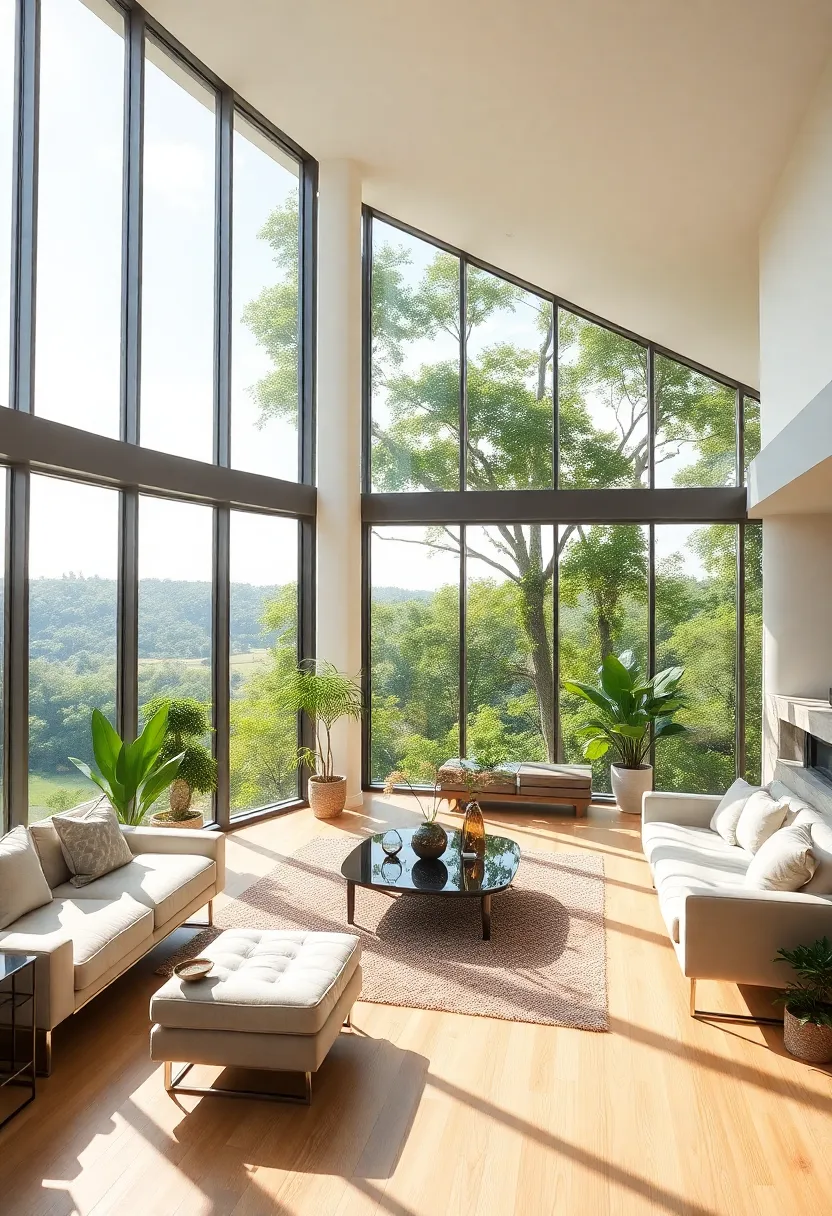
Floor-to-ceiling windows can completely transform your living room. They invite natural light and create an illusion of spaciousness, making your space feel airy and open. Imagine large panes of glass that frame beautiful outdoor views, letting nature become part of your home. Pinterest is buzzing with these designs, showcasing how they can elevate your interior décor effortlessly.
To bring this feature into your home, consider using sheer curtains for privacy while maintaining the view. Arrange your furniture to maximize the light and keep the space feeling open. Think about adding indoor plants to contrast beautifully with the glass. With this setup, your living room will become a bright, inviting haven, perfect for relaxation and gatherings.
• Use sheer curtains for privacy without blocking light.
• Position furniture to maximize natural light.
• Add indoor plants for a fresh touch.
• Choose neutral colors to enhance the airy feel.
By incorporating these windows, you’ll create a stunning living area that feels expansive and welcoming.
Floor-to-Ceiling Windows
Editor’s Choice


OWENIE Sheer Curtains 84 inches Long 2 Panels Set for Living Room/Bedroo…
 Amazon$7.93
Amazon$7.93
Costa Farms Live Plants (3 Pack), Easy to Grow Real Indoor Houseplants, …
 Amazon$31.13
Amazon$31.132. Window Seats with a View
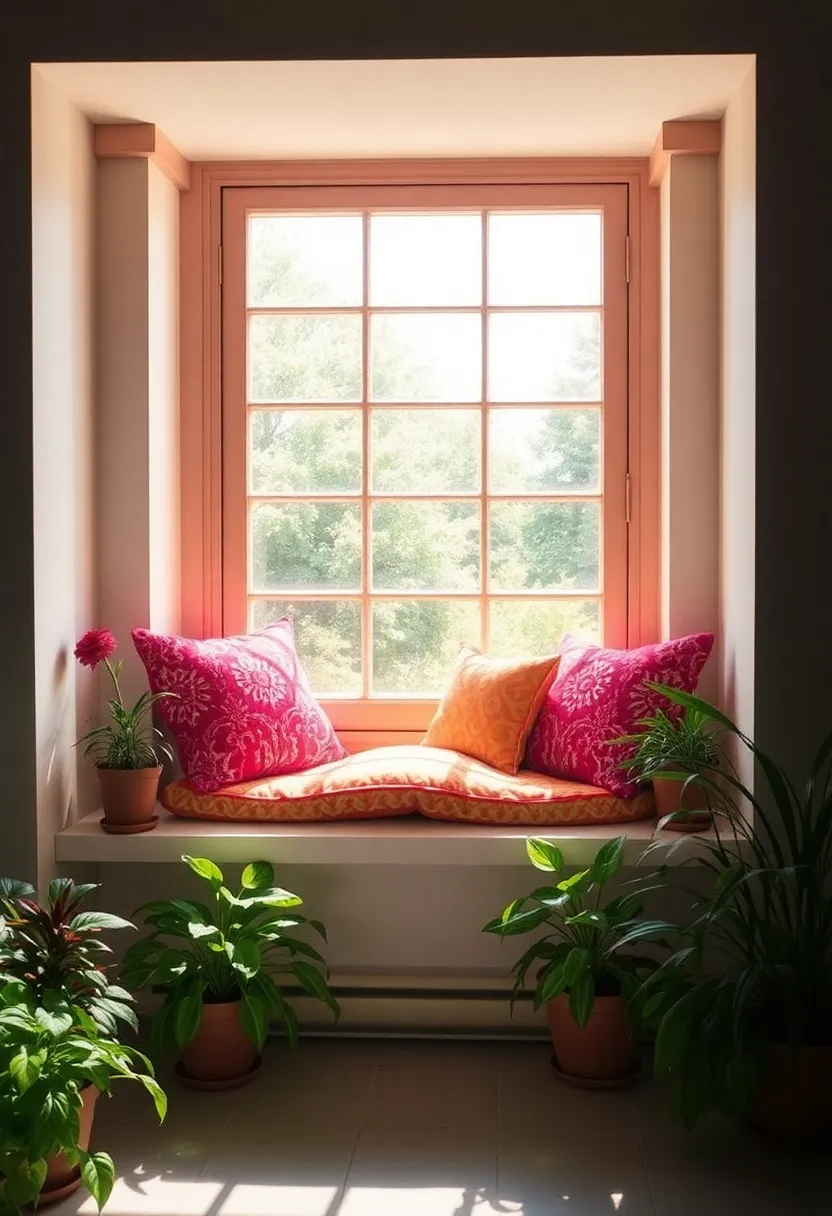
Imagine curling up with a good book in a sunny window seat. This cozy nook can become your favorite spot in the house. A large window paired with comfortable seating creates the perfect retreat to relax and enjoy the view. Many people love the charm of a window seat, as it adds both style and functionality to your living room.
To create your own window seat, build a cushioned bench with plenty of soft pillows for comfort. Consider adding shelves or storage underneath to keep everything organized. Use warm colors and various textures to make this area feel inviting. Your window seat will not only be a wonderful place to unwind but also a beautiful focal point in your living room.
• Build a cushioned bench for comfort.
• Add bookshelves for storage and organization.
• Use colors and textures to enhance warmth.
• Position it to maximize the view outside.
A window seat turns your living room into a cozy retreat that invites relaxation and warmth.
Window Seats with a View
Editor’s Choice

Custom Window Seat Cushions Indoor, Circle Fleece Bay Window Cushion, Wa…
 Amazon$9.18
Amazon$9.18
Rough Country Under Seat Storage for Chevy Silverado 1500 (2019-2025) & …
 Amazon$119.95
Amazon$119.95
Multicolored Rainbow Abstract Throw Pillow Covers 18×18 in Set of 2, Dec…
 Amazon$9.99
Amazon$9.993. French Doors Leading to a Patio
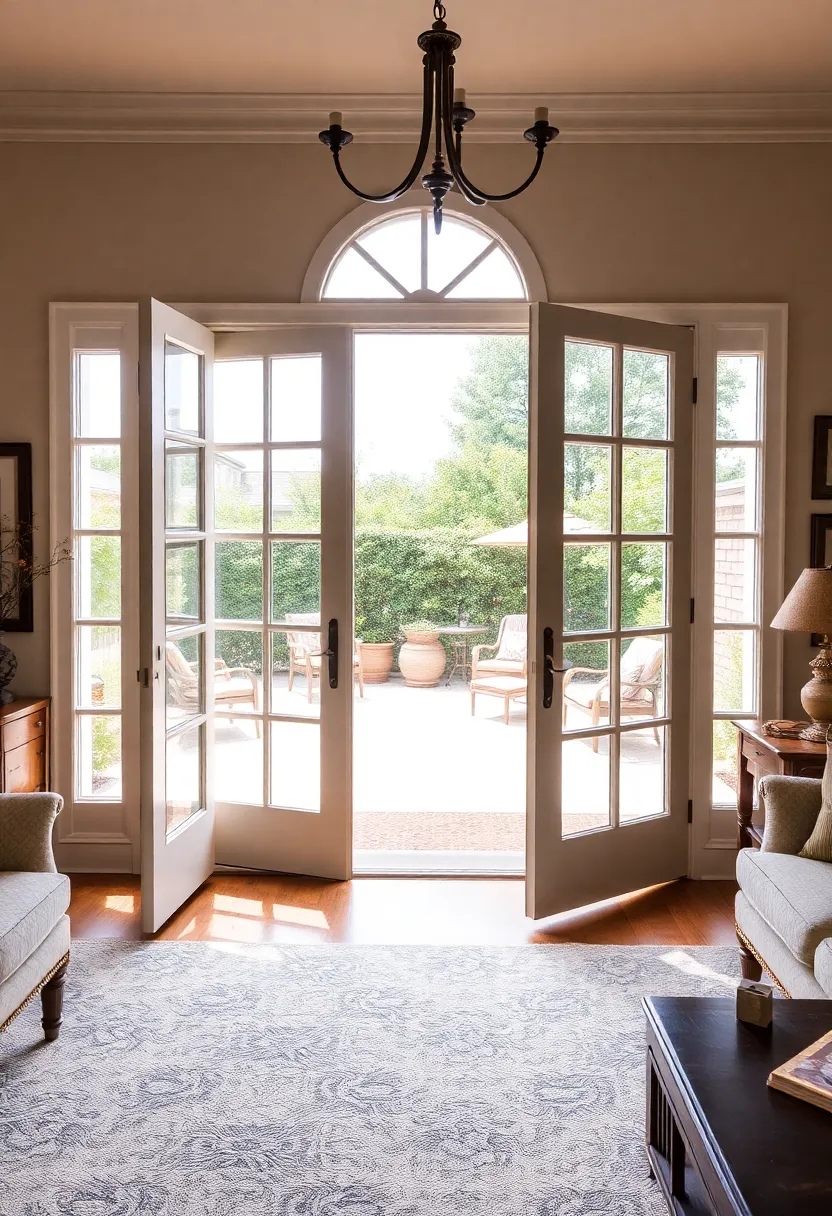
French doors offer a stylish entryway to your patio, creating a seamless indoor-outdoor experience. These elegant doors flood your living room with natural light while framing lovely views outside. They can be the perfect addition if you want to bring the beauty of your garden indoors. Many design experts highlight their charm as a way to elevate your home’s aesthetic.
When choosing French doors, consider styles that match your home. You can frame them with outdoor plants or furniture to create an inviting entrance. Instead of blinds, think about using soft curtains to maintain a light and airy feel. This feature not only brightens your space but also enhances the connection between your living room and the outdoors.
• Choose matching styles for your existing décor.
• Frame with plants or outdoor furniture for charm.
• Use curtains instead of blinds for softness.
• Position furniture to highlight the doors.
With French doors, your living room can become an inviting space that connects beautifully with nature.
French Doors Leading to a Patio
Editor’s Choice

MIULEE Natural White Linen Curtains 84 Inch Long for Bedroom Living Room…
 Amazon$18.95
Amazon$18.95
Artificial Flowers Outdoor Fake Plants – 12 Bundles UV Resistant No Fade…
 Amazon$23.98
Amazon$23.98
Berlin Modisch Entrance Lever Door Handle (for Office and Front Door) Re…
 Amazon$36.99
Amazon$36.994. Skylights for Extra Light
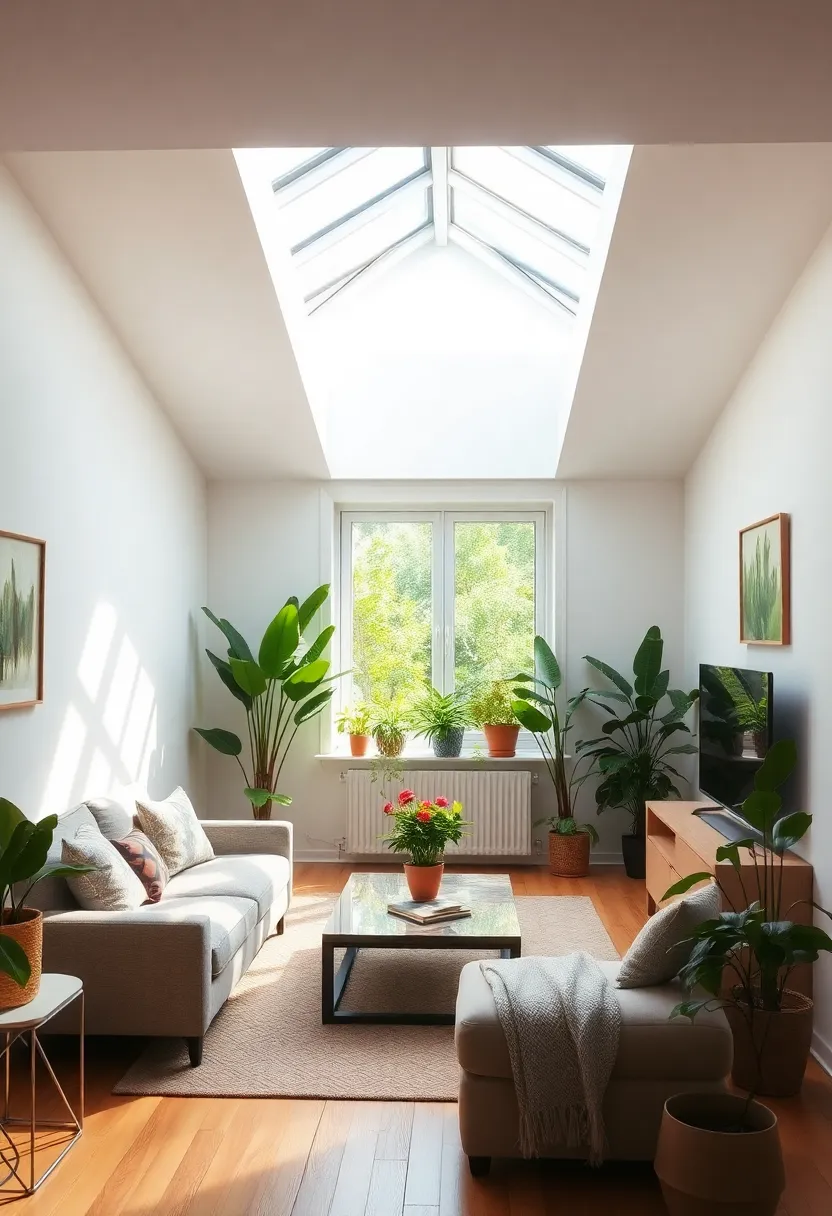
Skylights are a fantastic way to add bright, natural light to smaller living rooms. They create an open and airy feel, making your space feel larger and more inviting. Even in compact areas, skylights can dramatically change the atmosphere, filling the room with sunlight. Many homeowners are adopting this trend to enhance their living spaces.
To install skylights, think about the positions that will let in the most light while maintaining privacy. They can also help reduce your electricity bill by limiting the need for artificial light. Consider using vented skylights for added airflow. With skylights, your living room will feel more cheerful and welcoming, encouraging family gatherings and relaxation.
• Choose strategic placements for maximum light.
• Consider vented options for added airflow.
• Use fixed styles for a minimalist look.
• Pair with light-colored walls to enhance brightness.
Incorporating skylights will make your living room a bright, cheerful space that invites joy.
Skylights for Extra Light
Editor’s Choice

Skylights & Roof Windows, Custom 19.7-47.2in Roof Skylight Window with G…
 Amazon$312.45
Amazon$312.45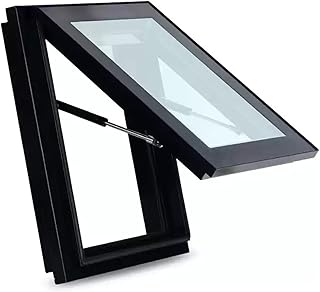
Hand Skylight, Clear Roof Window for Shed, Rooftent, Basement, Garage, S…
 Amazon$154.70
Amazon$154.70
NeatiEase Flexible Trim Caulk Strip, Peel and Stick Trim for Molding, Ti…
 Amazon$26.99
Amazon$26.995. Arched Windows for Elegance

Arched windows bring an elegant touch to any living room. Their unique shape creates a sense of height, making even smaller spaces feel grand. These windows complement various home styles, from modern to traditional, adding charm and character. Many designers appreciate their ability to enhance the overall aesthetic of a room.
To style arched windows, use elegant curtains that match your décor. You can display artwork above the arch to draw attention and add flair. Consider furniture that mimics the arch shape to create a cohesive look. With arched windows, your living room will be bright, welcoming, and sophisticated.
• Frame with elegant curtains for a stylish touch.
• Display artwork above the arch for interest.
• Choose mirrored furniture to reflect light.
• Incorporate light colors to maintain brightness.
Arched windows will elevate your living room into an elegant sanctuary filled with natural light.
Arched Windows for Elegance
Editor’s Choice

Petrichor Elegant Curtains with Gold Silver Threads 2 Panels Set – Luxur…
 Amazon$39.99
Amazon$39.99
Lifewit 1.5″ x 12″ Narrow Floating Shelves for Vinyl Record 6 Pack, Clea…
 Amazon$9.98
Amazon$9.986. Sliding Glass Walls
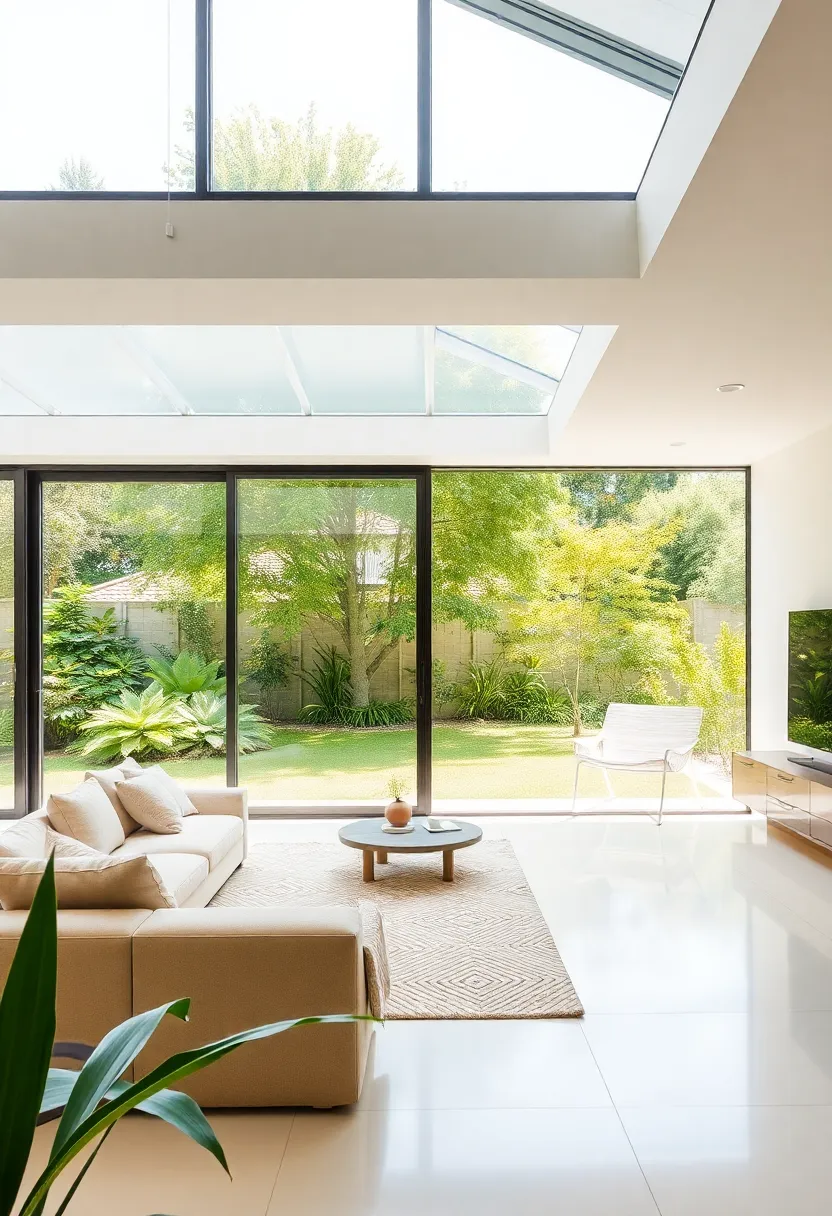
Sliding glass walls are a stunning way to merge your indoor and outdoor spaces. They open completely, allowing fresh air and natural light to flow into your living room. This design is ideal for entertaining, creating a spacious and inviting atmosphere. Many homeowners love the beauty and functionality of sliding glass walls.
When choosing sliding walls, pick a design that fits your style and space. Ensure they glide smoothly for easy access. Consider adding outdoor furniture to extend your living area. With sliding glass walls, your home will feel more connected to nature, perfect for gatherings and relaxation.
• Choose stylish designs that fit your space.
• Ensure they glide smoothly for ease of use.
• Incorporate outdoor furniture for seamless flow.
• Use light colors to enhance brightness.
Sliding glass walls transform your living room into a beautiful, airy space that invites the outdoors in.
Sliding Glass Walls
Editor’s Choice

Homall 4 Pieces Outdoor Patio Furniture Sets Rattan Chair Wicker Set,Out…
 Amazon$139.99
Amazon$139.99
NICETOWN Grey Blackout Patio Sliding Door Curtains 84 inch Length, Gromm…
 Amazon$17.51
Amazon$17.51
Snuggle Hollow Ceramic Vase Set of 2, Nordic Modern Boho ins Style Decor…
 Amazon$29.99
Amazon$29.997. Bay Windows to Create Space
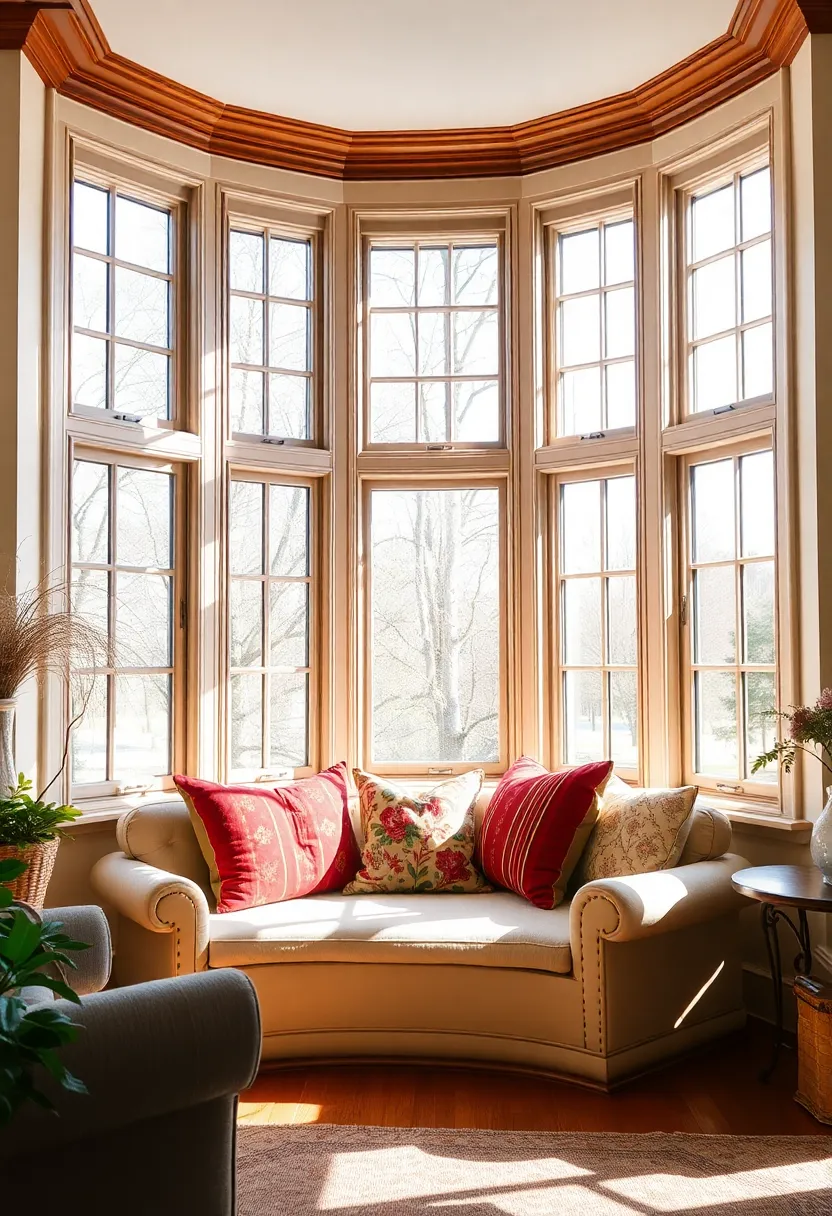
Bay windows add a charming touch and extra space to your living room. They extend beyond the wall, offering a cozy nook or additional seating. These windows invite light and provide lovely views, creating a warm atmosphere. Many people love the functionality and appeal of bay windows.
To style bay windows, create a reading nook with cushions and throws for comfort. You can place decorative items or plants on the ledge for added interest. Arrange furniture to highlight the bay window, drawing attention to its unique shape. With bay windows, your living room will feel fuller and more inviting.
• Create a reading nook with cushions and throws.
• Add decorative items on the ledge for charm.
• Position furniture to highlight the window.
• Use soft lighting to enhance comfort.
Bay windows turn your living room into a cozy haven filled with light and warmth.
❝ Bay windows are a standout in large window ideas for living room, turning extra wall space into a cozy nook with built-in seating. Dress the ledge with cushions and a plant, then angle furniture to frame the view for a room that feels bigger and brighter. ❞
Bay Windows to Create Space
Editor’s Choice

Moon Pillow, Decorative Throw Pillows with Soft Faux Rabbit for Bed Couc…
 Amazon$9.99
Amazon$9.99
Gepege 6 Inch Beaded Ceramic Planter Set of 2 with Drainage Hole and Sau…
 Amazon$19.99
Amazon$19.99
Bedsure GentleSoft White Throw Blanket for Couch – Cozy Blanket for Wome…
 Amazon$12.34
Amazon$12.348. Large Casement Windows

Casement windows are an excellent choice for maximizing light and airflow in your living room. They open outward, allowing fresh air to circulate while keeping your space bright. Their clean lines fit various home styles, making them a popular option. Many homeowners appreciate their practicality and aesthetic appeal.
When selecting casement windows, look for options that open easily for ventilation. They can be combined with other window types to create a unique look. Choose frames that match your décor for a cohesive design. With large casement windows, you enhance both comfort and style in your living room.
• Choose easy-to-open styles for ventilation.
• Combine with other window types for uniqueness.
• Match frame colors to your décor.
• Use large panes to maximize light.
Incorporating casement windows will enhance your living room’s brightness and airiness.
Large Casement Windows
Editor’s Choice

OWENIE Sheer Curtains 84 inches Long 2 Panels Set for Living Room/Bedroo…
 Amazon$7.93
Amazon$7.93
Comfort Zone Twin Window Fan with Reversible Airflow Control, 9 inch, Au…
 Amazon$38.56
Amazon$38.569. Divided Light Windows
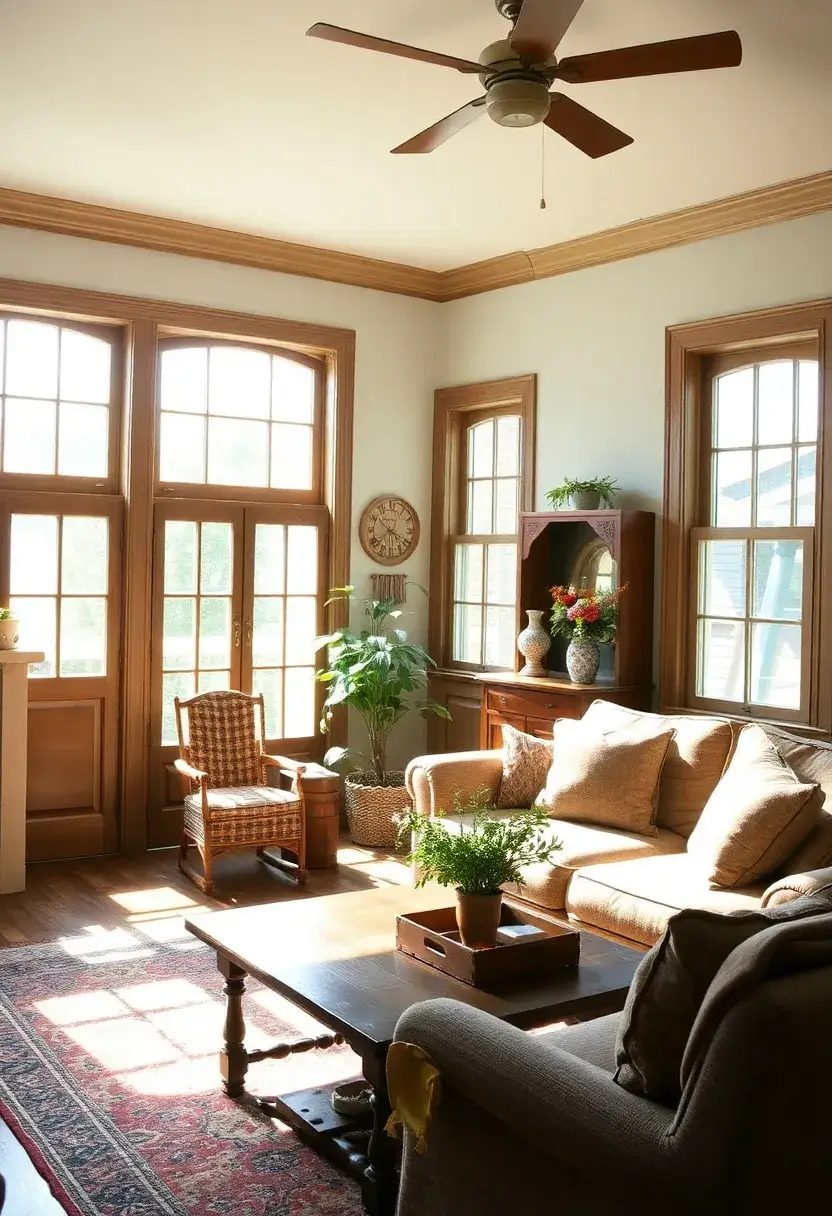
Divided light windows add a vintage charm to your living room while allowing ample light to enter. Their classic grid design creates character and opens up creative design possibilities. These windows are perfect for those who want to add a nostalgic touch while maximizing brightness. Many design enthusiasts love the style and functionality they bring.
To enhance the look of divided light windows, pair them with rustic or farmhouse décor. Using vintage hardware can enhance their historical appeal. Consider combining them with blackout shades for privacy at night. With divided light windows, your living room will be bright and full of character.
• Pair with rustic décor for a cohesive look.
• Use vintage hardware for added charm.
• Combine with blackout shades for privacy.
• Position furniture to highlight the windows.
Divided light windows make your living room a unique and inviting space filled with light.
Divided Light Windows
Editor’s Choice

GORGECRAFT 30PCS 1.5″ Rusty Metal Barn Star Vintage Antique Primitives C…
 Amazon$7.49
Amazon$7.49
100% Blackout Curtains for Bedroom, Portable DIY Window Blinds, No Drill…
 Amazon$19.98
Amazon$19.9810. Wraparound Windows
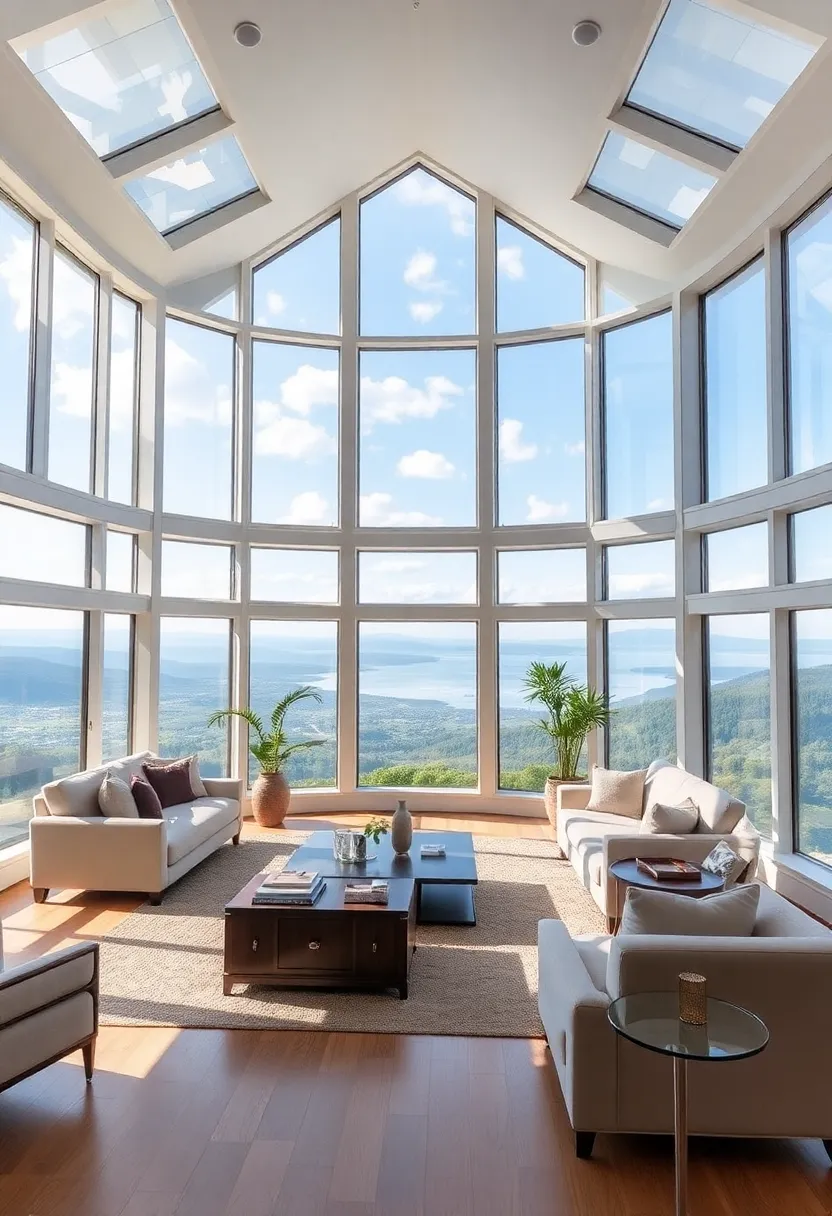
Wraparound windows create beautiful panoramic views by wrapping around the corners of your living room. They allow light to flood in from different angles, enhancing the spacious feel of the room. This design is great for connecting you with the outdoors, making your living space feel more open. Many homeowners love the immersive experience these windows provide.
When using wraparound windows, opt for minimalist window treatments to keep the look clean. Arrange your furniture to highlight the view and create a focal point. Use light-colored walls to reflect brightness throughout the space. With wraparound windows, your living room can become a haven of natural light.
• Use minimalist window treatments for a clean look.
• Highlight views with strategically placed furniture.
• Choose light colors for walls to reflect brightness.
• Add soft textures to enhance comfort.
Wraparound windows will transform your living room into a bright oasis that invites relaxation.
Wraparound Windows
Editor’s Choice

Light Filtering Roller Shades for Windows 5% Openness Solar Shades UV Pr…
 Amazon$29.80
Amazon$29.80
Diamond Brite Paint Semi Gloss Latex Paint 1 Gallon in Soft Blue 22300-1
 Amazon$37.99
Amazon$37.9911. Large Picture Windows
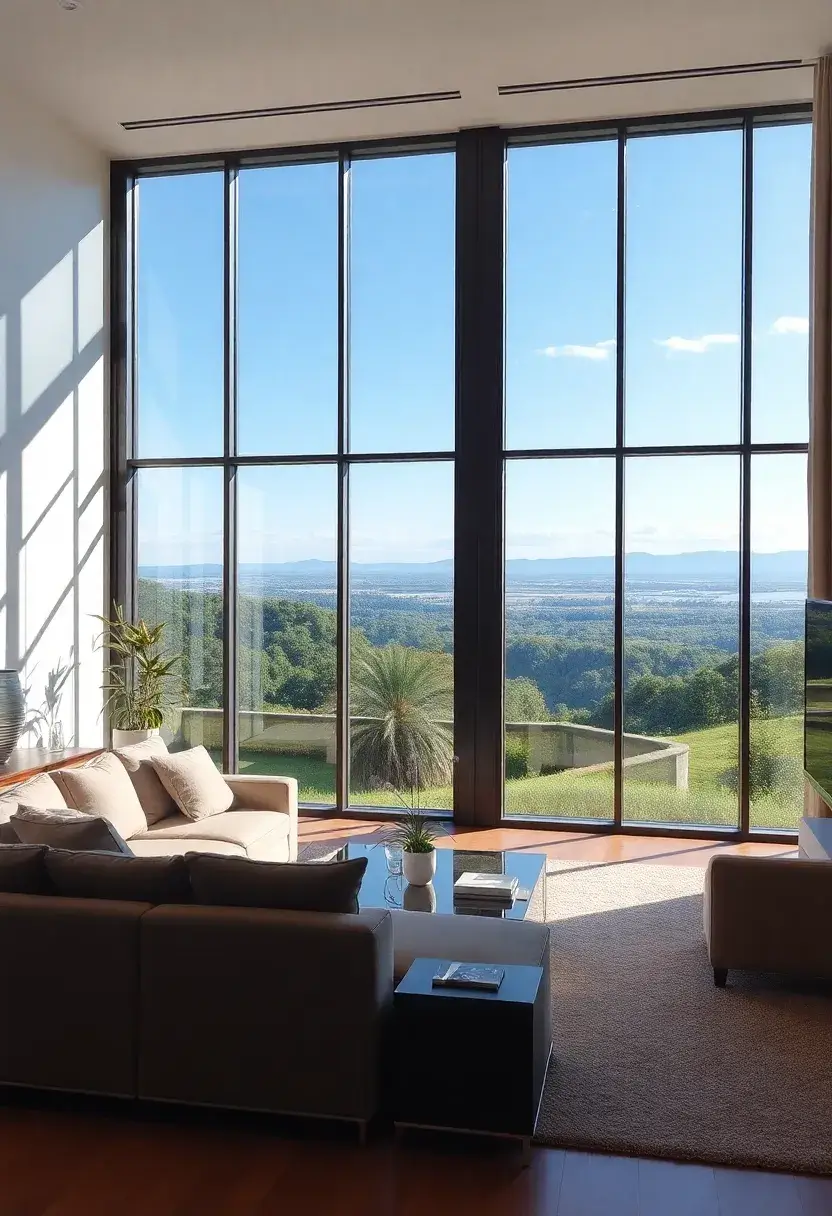
Picture windows are perfect for framing stunning views and maximizing light in your living room. These fixed windows provide an unobstructed view of the outdoors, acting as a piece of art that brings the outside in. They create a sense of openness, making your living area feel expansive. Many design lovers appreciate their aesthetic and functional benefits.
To enhance picture windows, keep the space beneath clear for low furniture, which helps maintain the view. Adding greenery nearby can enhance the natural vibe of the room. Choose frame colors that complement your interior design for a cohesive look. With picture windows, your living room will be bright, open, and inviting.
• Keep the space beneath clear for low furniture.
• Add greenery nearby for a fresh vibe.
• Choose complementary frame colors for cohesiveness.
• Use soft lighting to enhance ambiance.
Picture windows will make your living room feel expansive and filled with light.
❝ Fun fact: Large picture windows are one of the big large window ideas for living room— they can make a room feel 20–30% larger by bringing the outdoors in. Keep the space beneath clear with low-profile furniture to preserve the view and maximize daylight.
Large Picture Windows
Editor’s Choice

Christopher Knight Home Mores Low Profile Accent Chair Set of 2, Modern …
 Amazon$260.99
Amazon$260.99
Costa Farms Live Plants (3 Pack), Easy to Grow Real Indoor Houseplants, …
 Amazon$31.13
Amazon$31.13
CALIFORNIA CADE ELECTRONIC Rustic Wall Decor-Home Decor Window Barnwood …
 Amazon$22.99
Amazon$22.9912. Transom Windows
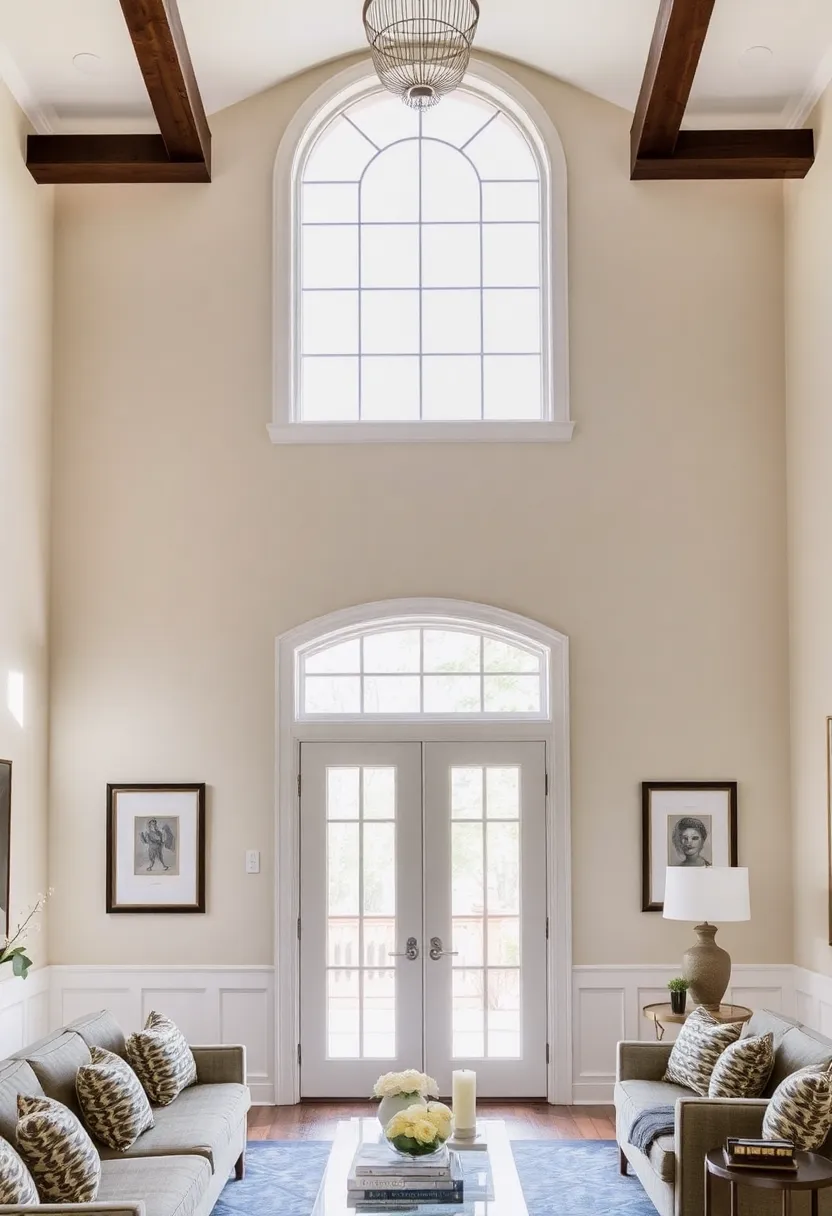
Transom windows are stylish additions placed above doors and other windows. They allow extra light in while adding an architectural element to your living room design. These smaller windows maximize natural light in tighter spaces, creating an inviting ambiance. Many homeowners appreciate their ability to enhance both style and brightness.
When incorporating transom windows, pair them with tall doors for a cohesive and elegant look. Use decorative molding to highlight their features and add flair. Make sure they can be opened for ventilation if possible. With transom windows, your living room will feel brighter and more sophisticated.
• Pair with tall doors for a cohesive look.
• Use decorative molding for added interest.
• Ensure they can open for ventilation.
• Choose light colors to enhance brightness.
Transom windows will brighten your living room while adding a chic architectural touch.
Transom Windows
Editor’s Choice

Pangda Peel and Stick Wall Molding Kit, 3D Premade Accent Molding Wainsc…
 Amazon$119.99
Amazon$119.99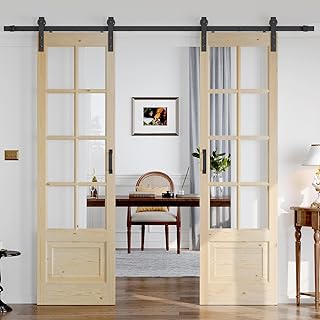
Preassembled 48×84 (Double 24×84) Inch Clear Glass French Interior Door …
 Amazon$339.99
Amazon$339.99
8pcs Window Box Planter,17 Inches Flower Window Boxes,Rectangle Planters…
 Amazon$26.99
Amazon$26.9913. Corner Windows

Corner windows create a light-filled space that connects beautifully with the outdoors. By positioning windows at the corners of your living room, you maximize views and invite sunlight in. This design fosters an open, airy atmosphere, making your space feel both cozy and expansive. Many homeowners love the bright and welcoming feel corner windows provide.
To enhance corner windows, avoid heavy drapes that can block light. Instead, use light-colored furnishings to reflect brightness and keep the space airy. Decorate with low plants to allow light to flow freely. With corner windows, your living room will feel vibrant and harmonious with nature.
• Avoid heavy drapes to keep the space open.
• Use light-colored furnishings to reflect brightness.
• Decorate with low plants for unobstructed light.
• Incorporate natural textures for warmth.
Corner windows will transform your living room into a lively space that invites relaxation.
Fun fact: Corner windows can boost natural light by up to 40% and make your living room feel bigger with the same square footage. Swap heavy drapes for light furnishings and reflective surfaces for a brighter, more open space—perfect in our large window ideas for living room.
Corner Windows
Editor’s Choice

OWENIE Sheer Curtains 84 inches Long 2 Panels Set for Living Room/Bedroo…
 Amazon$7.93
Amazon$7.93
Fancy Homi Set of 2 Light Blue Decorative Throw Pillow Covers 18×18 Inch…
 Amazon$14.98
Amazon$14.98
Costa Farms Live Plants (3 Pack), Easy to Grow Real Indoor Houseplants, …
 Amazon$31.13
Amazon$31.1314. Fixed Glass Panels
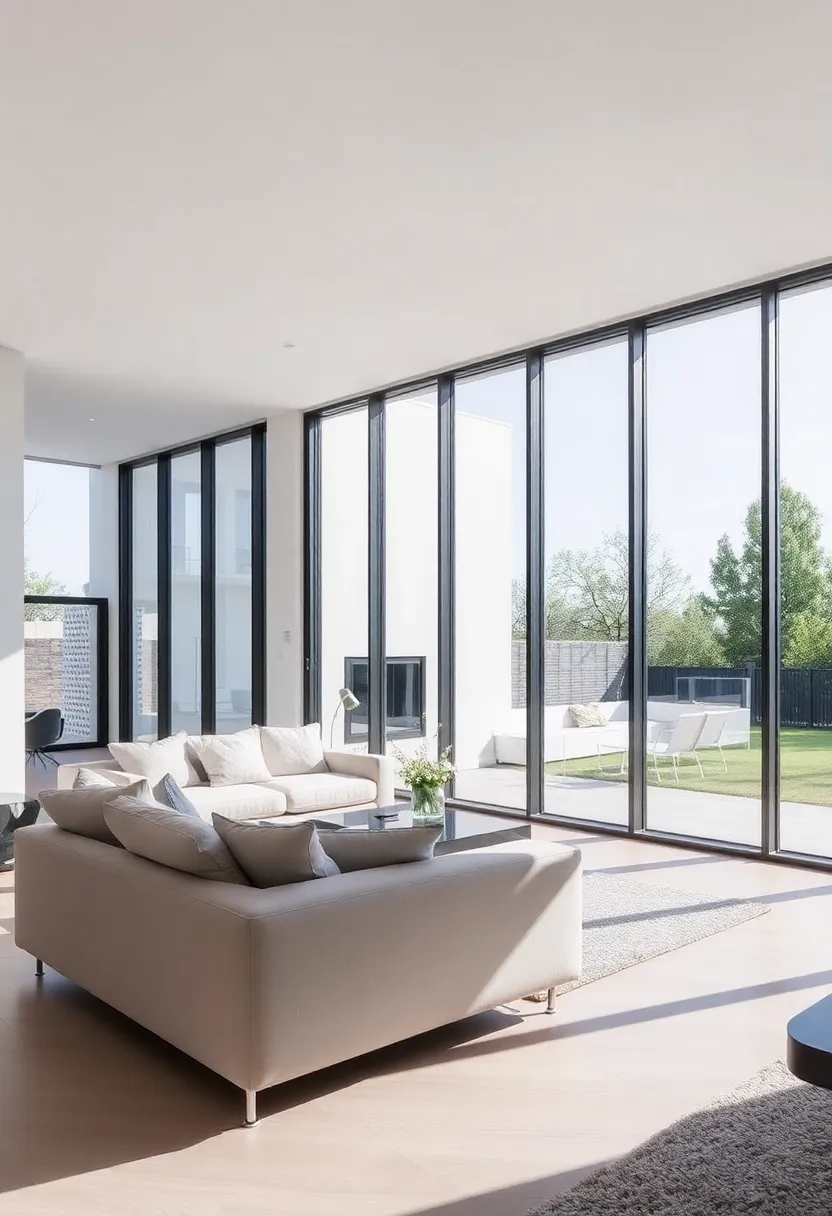
Fixed glass panels offer a sleek, modern touch to your living room design. These large panels maximize light and views while creating a minimalist aesthetic. They can be arranged in various configurations to suit your space, providing a unique and streamlined look. Many design enthusiasts appreciate their ability to enhance brightness.
When using fixed glass panels, choose frames that match your room’s color scheme for a cohesive design. Consider using them alongside sliding doors for versatile access. Keep the décor low to let the panels shine, maintaining a clean and open feel. With fixed glass panels, your living room will feel bright and airy.
• Choose matching frames for a cohesive look.
• Use alongside sliding doors for versatility.
• Keep décor low to enhance brightness.
• Opt for minimalist designs to maintain simplicity.
Fixed glass panels will make your living room feel modern and inviting.
Fixed Glass Panels
Editor’s Choice

Prime-Line MP2082 Sliding Door 1/2 In. Wide Keeper with Chrome Plated Di…
 Amazon$6.79
Amazon$6.79
AceList Set of 3 Glass Photo Frame Collection Simple Metal Geometric Pic…
 Amazon$37.99
Amazon$37.9915. Large Awning Windows

Awning windows are a versatile choice for enhancing ventilation and light in your living room. Hinged at the top, these windows open outward, allowing fresh air to flow while keeping rain out. They’re practical even in wet weather and offer privacy without sacrificing light. Many homeowners appreciate their functionality and style.
When choosing awning windows, think about combining them with larger stationary windows for an eye-catching design. They provide maximum airflow while remaining securely closed. Available in various sizes, they can fit your space perfectly. With awning windows, your living room will feel fresh and bright.
• Combine with larger stationary windows for style.
• Ensure they open easily for airflow.
• Choose varied sizes to fit your space.
• Use light frames to enhance brightness.
Awning windows will give your living room a stylish touch while ensuring it stays bright and airy.
Large Awning Windows
Editor’s Choice

idh by St. Simons 21001-10B Professional Grade Quality Genuine Solid Bra…
 Amazon$35.99
Amazon$35.99
OWENIE Sheer Curtains 84 inches Long 2 Panels Set for Living Room/Bedroo…
 Amazon$7.93
Amazon$7.9316. Glass Block Windows
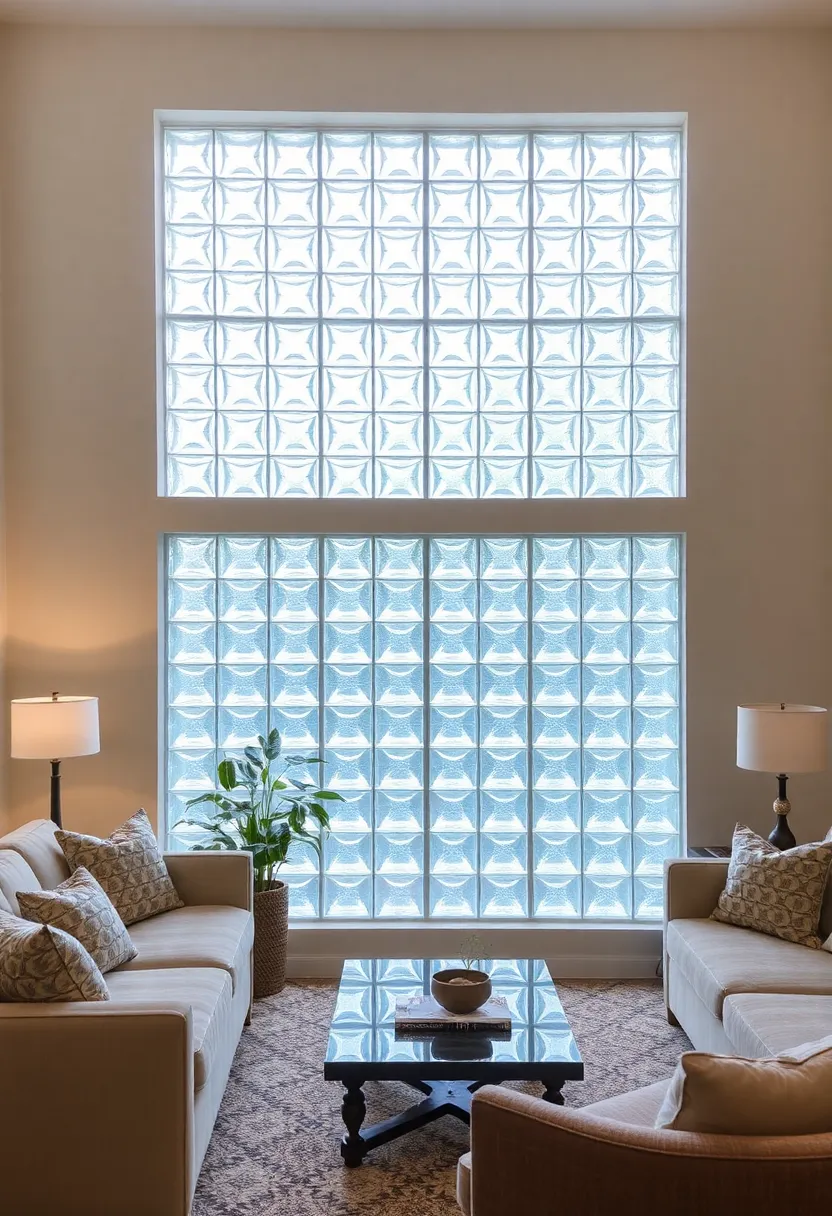
Glass block windows are a creative way to add light while maintaining privacy. These frosted blocks create a beautiful texture and let light filter in without compromising seclusion. They’re perfect for smaller living rooms that want to feel open and bright. Many design lovers appreciate their unique style.
Consider using glass blocks as a decorative wall feature to separate spaces creatively. You can also combine them with other window types for an eclectic design. Opt for colored blocks for an artistic touch that adds character to your living space. With glass block windows, your living room will feel playful and inviting.
• Use as a decorative wall feature for separation.
• Combine with other window types for style.
• Choose colored blocks for artistic flair.
• Arrange furniture to highlight the windows.
Glass block windows will brighten your living room while adding a unique touch to your design.
Glass Block Windows
Editor’s Choice

4 Pack-7.48″x7.48″x3.54″ High Transparency ice Crystal Patterned Square …
 Amazon$75.98
Amazon$75.98
1 Pack-7.48″x7.48″x3.54″ High Transparency ice Crystal Patterned Square …
 Amazon$25.98
Amazon$25.98
YAKAMOZ LED Lights Display Base,7 Colored Square Wooden Lighted Base Sta…
 Amazon$9.99
Amazon$9.9917. Bi-Fold Windows

Bi-fold windows are an exciting option that combines style and functionality. These large windows fold open completely, allowing seamless access between your indoor living space and the outdoors. They’re perfect for entertaining, creating a warm and inviting atmosphere. Many homeowners love how they encourage outdoor living.
When choosing bi-fold windows, select a design that complements your existing architecture for a cohesive look. Installing screens can keep insects out while allowing airflow. Consider incorporating outdoor furnishings to enhance your living area outside. With bi-fold windows, your living room will feel connected to nature.
• Choose a cohesive design for style.
• Install screens to keep insects out.
• Use outdoor furnishings to enhance the space.
• Maintain minimal décor for an open feel.
Bi-fold windows will create a welcoming living room that invites nature inside.
Bi-Fold Windows
Editor’s Choice

Mesh Screen with Magnetic Closure-Keeps Bugs Out Let Breeze in, Heavy Du…
 Amazon$24.99
Amazon$24.99
ABenkle 8 Pcs Drink Coasters with Holder, Cotton Woven Absorbent Coaster…
 Amazon$9.99
Amazon$9.9918. Large Pivot Windows
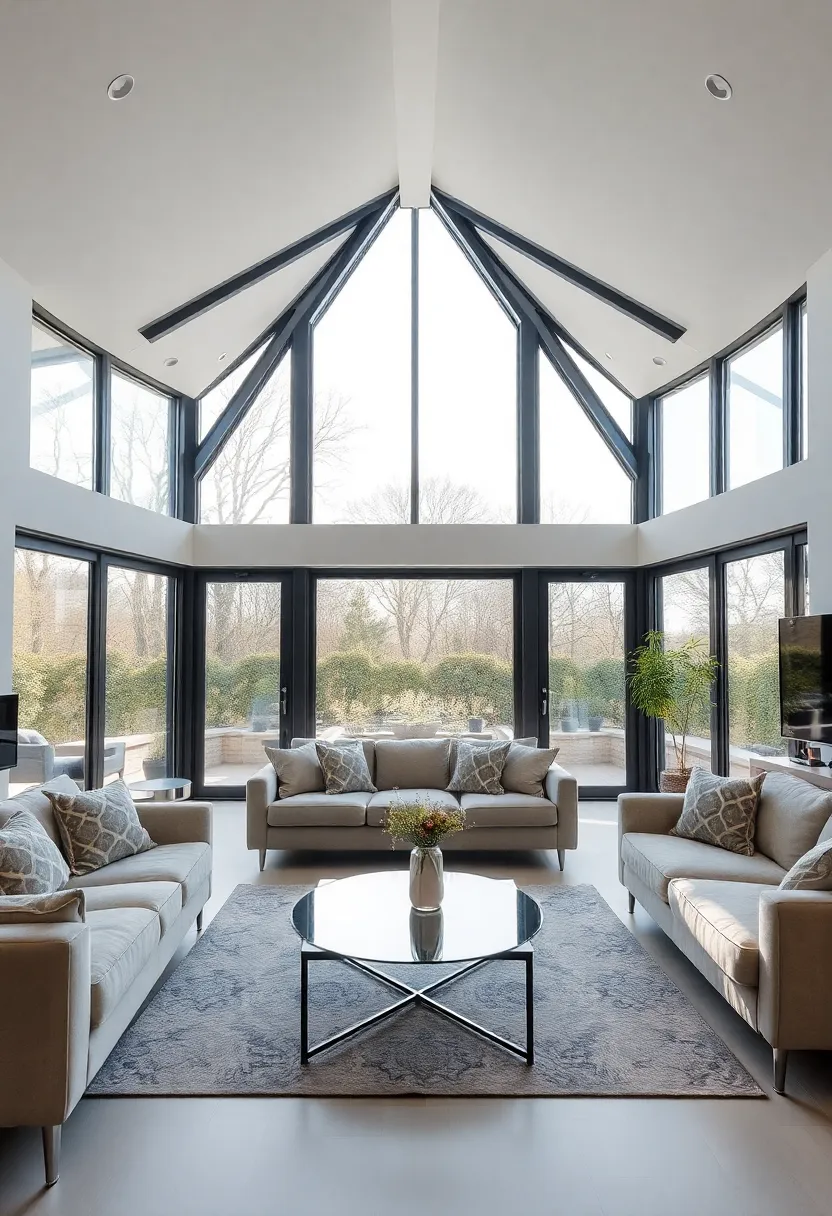
Pivot windows offer a unique choice that enhances versatility and style in your living room. These windows rotate on a central axis, allowing fresh air to flow in creatively. They can be arranged in various configurations, optimizing light while adding a modern touch. Many design lovers appreciate their artistic appeal.
When selecting pivot windows, ensure they open easily, even in hard-to-reach areas. They can serve as an artistic focal point in your living room, drawing attention and enhancing the design. Available in custom sizes, they will fit your unique space perfectly. With pivot windows, your living room will feel fresh and stylish.
• Ensure they open easily for convenience.
• Use as an artistic focal point in the room.
• Consider custom sizes for a perfect fit.
• Pair with minimalist décor for style.
Pivot windows will give your living room a modern update while maximizing light and ventilation.
Large Pivot Windows
Editor’s Choice

Frost King V76H Shrink Window Kit 84-Inch by 110-Inch, Clear
 Amazon$7.67
Amazon$7.67
rabbitgoo Window Privacy Film Rainbow Film Decorative Window Sticker, 3D…
 Amazon$7.99
Amazon$7.9919. Vertical Sliding Windows

Vertical sliding windows are a classic choice that enhances your living room’s look while optimizing natural light. They open easily, allowing fresh air to flow in while creating a sense of height and elegance. Available in various styles and sizes, they fit well in tall spaces. Many homeowners appreciate their practicality and charm.
To style vertical sliding windows, pair them with layered curtains for a soft, inviting appearance. Use decorative trim around the windows to add character and interest. Opt for larger panes to maximize light entry, creating a bright and airy space. With vertical sliding windows, your living room will feel elegant and welcoming.
• Pair with layered curtains for softness.
• Use decorative trim for added charm.
• Choose larger panes for brightness.
• Arrange furniture to highlight the windows.
Vertical sliding windows combine practicality with elegance, making your living room a delightful space.
Vertical Sliding Windows
Editor’s Choice

NICETOWN Grey Blackout Patio Sliding Door Curtains 84 inch Length, Gromm…
 Amazon$17.51
Amazon$17.51
Car Window Weather Stripping Molding Trim Belt,Compatible with Honda Civ…
 Amazon$31.99
Amazon$31.99
Cut to Size Insulated Glass Panels – Custom Tempered Double Pane for Win…
 Amazon$89.99
Amazon$89.9920. Clerestory Windows
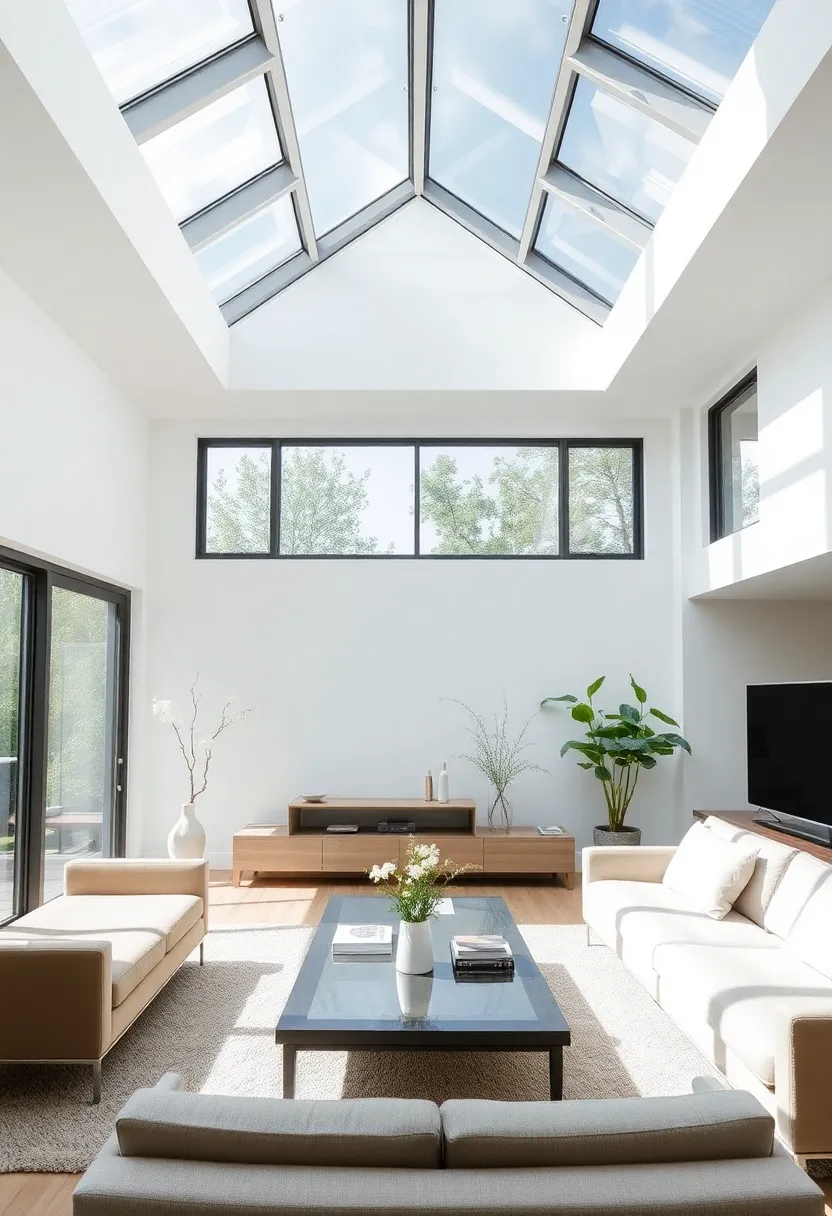
Clerestory windows are installed high on walls, providing additional light without consuming wall space. They are great for small living rooms, allowing sunlight to pour in while ensuring privacy. This design adds architectural interest while maximizing brightness. Many design enthusiasts enjoy their innovative appeal.
When using clerestory windows, combine them with larger windows for maximum effect. They create an illusion of height, enhancing your living room’s spacious feel. Often featured in modern homes, they lend a sleek look. With clerestory windows, your living room will feel bright and stylish.
• Combine with larger windows for maximum light.
• Use in modern designs for a sleek look.
• Ensure they are well-placed for natural light.
• Choose light colors to enhance brightness.
Clerestory windows will brighten your living room with style and innovation.
Clerestory Windows
Editor’s Choice

MIULEE 2 Panels Solid Color White Sheer Window Curtains Elegant Window V…
 Amazon$7.94
Amazon$7.94
rabbitgoo Window Privacy Film Rainbow Film Decorative Window Sticker, 3D…
 Amazon$7.99
Amazon$7.9921. Decorative Window Films
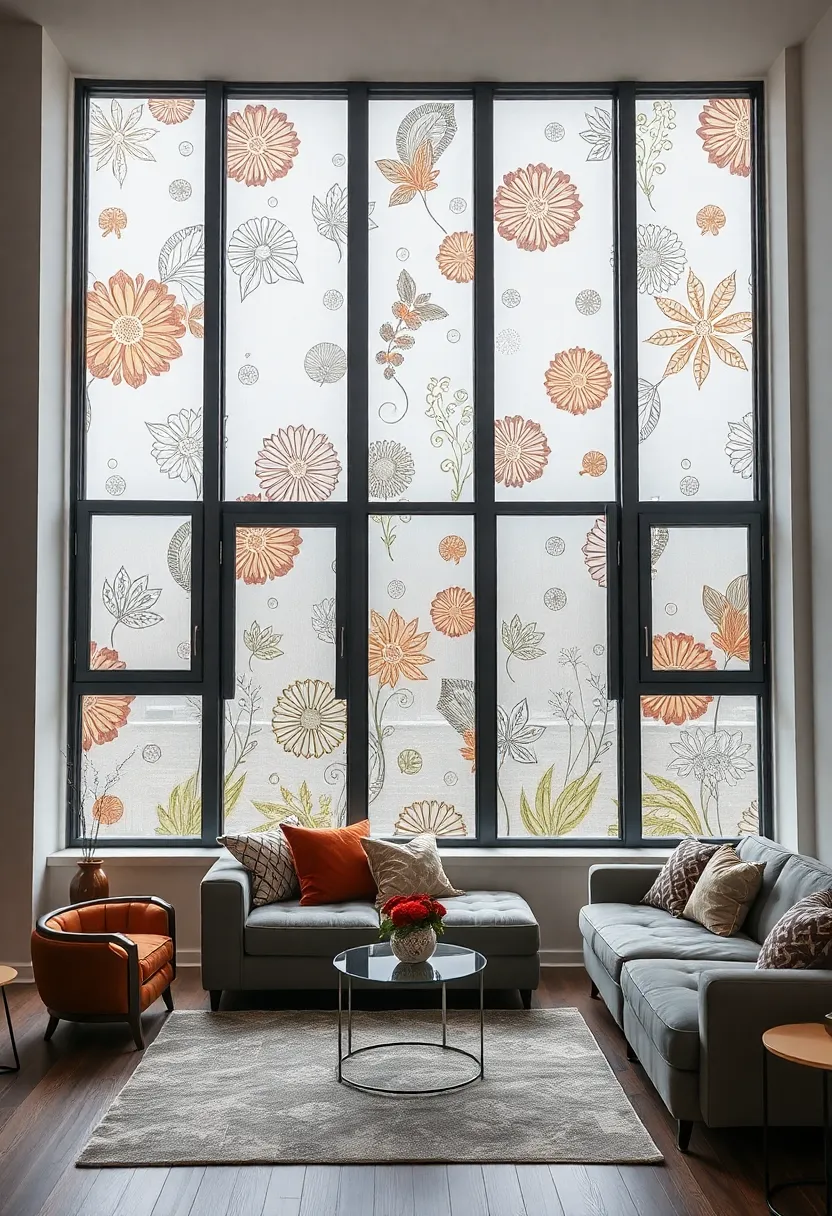
Decorative window films add a unique touch to your living space while allowing light to filter in. Available in various designs and patterns, they can provide privacy without blocking sunlight. These films are a quick and affordable way to enhance your living room without major renovations. Many homeowners love the creative possibilities they offer.
To personalize your windows, choose floral patterns for a soft, feminine touch. Geometric designs can bring a modern vibe to your space. Layering films can create texture and depth, enhancing your room’s design. With decorative window films, your living room will feel vibrant and inviting.
• Choose floral patterns for a soft touch.
• Opt for geometric designs for modern appeal.
• Layer films for added texture and depth.
• Apply to various windows for cohesive style.
Decorative window films will personalize your living room while optimizing natural light.
Decorative Window Films
Editor’s Choice

Retro Magnolia Flowers Window Privacy Film,Stained Glass Decals Colorful…
 Amazon$11.99
Amazon$11.99
DKTIE Stained Glass Window Film Geometric Patterns, Fine Frosted Window …
 Amazon$7.99
Amazon$7.99
Rainbow Window Privacy Film Decorative Window Sticker, 3D Static Stained…
 Amazon$6.99
Amazon$6.9922. Large Sliding Windows

Large sliding windows create a seamless transition between your indoor and outdoor spaces. These horizontally moving windows allow fresh air and natural light to flow freely into your living room. Their versatility makes them suitable for various styles, from modern to traditional. Many homeowners appreciate how they enhance the overall feel of their living space.
When incorporating large sliding windows, consider how they fit into your design. They are perfect for small spaces where outward-opening windows can be impractical. Ensure they provide unobstructed views of your surroundings. With large sliding windows, your living room will feel open and connected to nature.
• Choose designs that fit your overall style.
• Ensure they provide unobstructed views.
• Opt for easy-to-use mechanisms for convenience.
• Consider light colors to reflect brightness.
Large sliding windows will enhance your living room’s connection to the outdoors.
Large Sliding Windows
Editor’s Choice

Sliding Window, Shed Window with Screen, Basement Windows Aluminum Alloy…
 Amazon$77.80
Amazon$77.80
BGment Grass Green Black Out Curtains 63 Inch Long for Bedroom – Spring …
 Amazon$27.98
Amazon$27.9823. Decorative Window Grilles

Decorative window grilles add character to large windows while allowing light to flood your living room. These customizable patterns enhance your design while providing a unique touch. Grilles can be tailored in various styles, adding charm and detail to your windows. Many homeowners enjoy how they can refresh their space with this simple addition.
When selecting grilles, choose patterns that complement your overall décor theme. Contrasting colors can make a bold statement. Consider using removable grilles for flexibility in changing your style. With decorative window grilles, your living room will feel personalized and inviting.
• Choose patterns that complement your décor.
• Use contrasting colors for a bold look.
• Consider removable options for flexibility.
• Ensure they allow ample light to enter.
Decorative window grilles will enhance your living room’s charm while optimizing natural light.
Decorative Window Grilles
Editor’s Choice

Wrought Iron Decorative Grille, Window & Door Grille, Fleur de Lis Style…
 Amazon$116.85
Amazon$116.85
rabbitgoo Window Privacy Film Rainbow Film Decorative Window Sticker, 3D…
 Amazon$7.99
Amazon$7.9924. Angled Windows
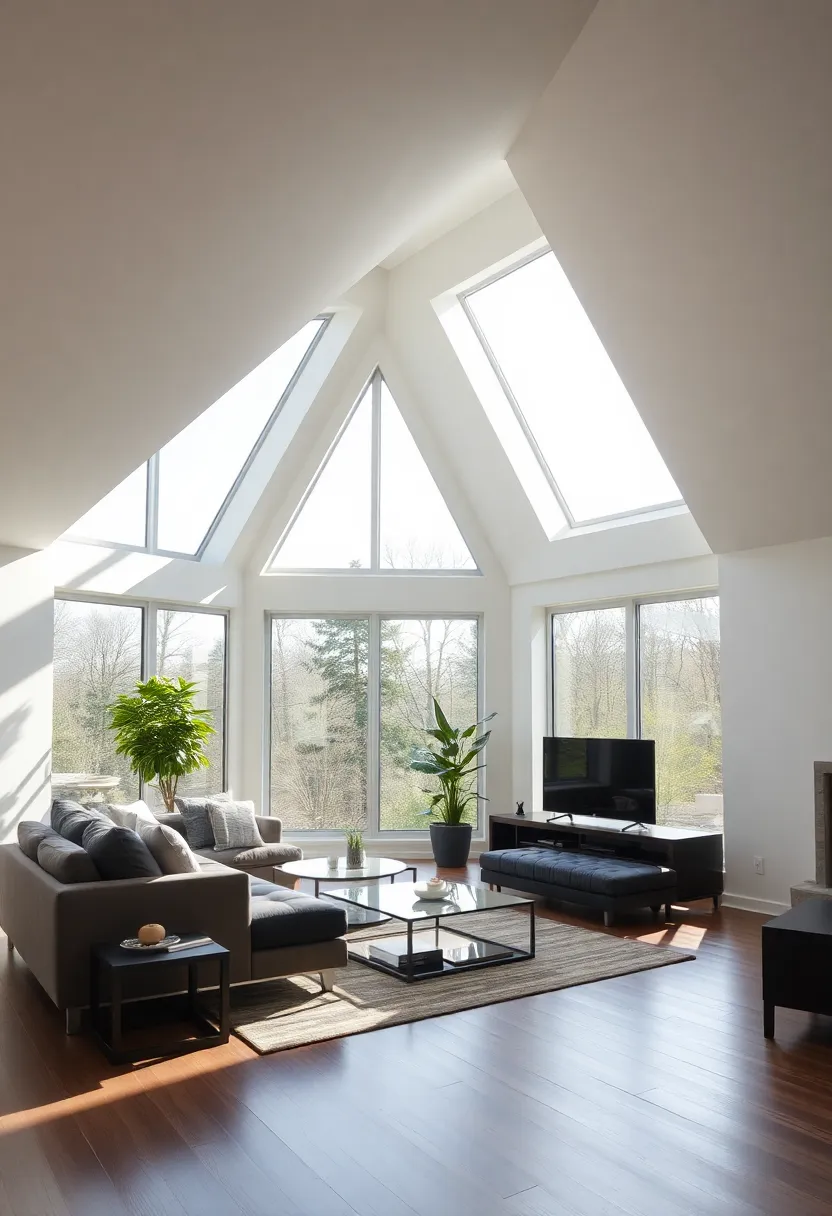
Angled windows offer a modern twist to traditional designs, allowing for ample light while adding architectural interest. These unique shapes capture the best views while maximizing sunlight throughout the day. Many design enthusiasts appreciate their ability to enhance room aesthetics and create dynamic visuals.
To style angled windows, consider how they can enhance your décor. They are perfect for contemporary homes or those with unique rooflines. Allow creative window treatments to play off their angles, enhancing their style. With angled windows, your living room will feel fresh and inviting.
• Create dynamic visuals with unique shapes.
• Use creative window treatments for added style.
• Consider their placement for optimal views.
• Pair with modern décor for a cohesive look.
Angled windows will give your living room a stylish update while optimizing natural light.
Angled Windows
Editor’s Choice

MIULEE 2 Panels Solid Color White Sheer Window Curtains Elegant Window V…
 Amazon$7.94
Amazon$7.94
1” Diameter Curtain Rods Itself is 30 to144 inch 1 Pack Fit 30-142 inch,…
 Amazon$14.99
Amazon$14.9925. Louvered Windows

Louvered windows enhance ventilation and light in your living room with their stylish design. These windows consist of horizontal slats that can be adjusted to control airflow while allowing light to filter in. They add sophistication to any space while optimizing natural light. Many homeowners appreciate their functionality and elegance.
When choosing louvered windows, consider their benefits for tropical climates, where airflow is essential. Pair them with larger fixed windows for a more dramatic effect. Available in various styles, they can fit your design perfectly. With louvered windows, your living room will feel bright and fresh.
• Adjust slats for custom airflow.
• Pair with fixed windows for dramatic style.
• Choose designs that fit your décor.
• Ensure they allow ample light to enter.
Louvered windows will create a bright and airy atmosphere in your living room.
Louvered Windows
Editor’s Choice
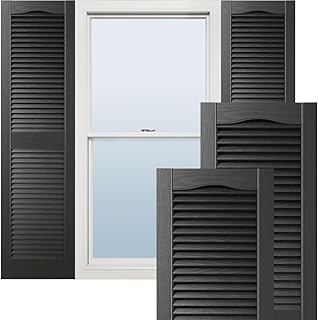
Ekena Millwork Lifetime Vinyl LL1S14X03600BL Standard Cathedral Top Cent…
 Amazon$39.93
Amazon$39.93
Frosted Glass Window Privacy Film Decorative, Bathroom Window Privacy Fi…
 Amazon$5.99
Amazon$5.99
Art3d 10 Ft Peel and Stick Flexible Vinyl Molding Trim for Wall Tile Edg…
 Amazon$6.99
Amazon$6.9926. Hexagonal Windows
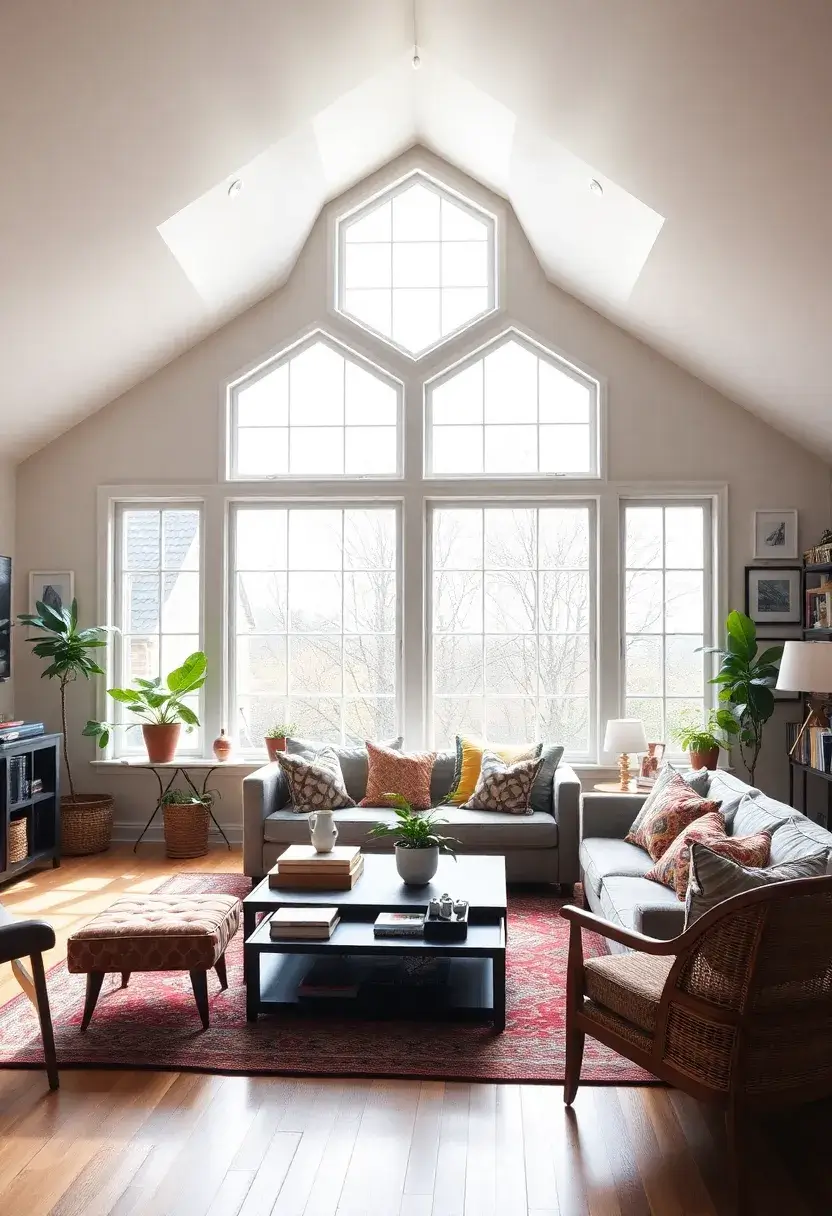
Hexagonal windows add a quirky and stylish touch to your living room. Their unique shape creates a stunning focal point while maximizing light. They work well in modern and eclectic designs, drawing the eye and adding character. Many design lovers appreciate their playful nature.
When styling hexagonal windows, pair them with minimalist furniture to let their design shine. Consider combining them with other geometric shapes for added visual interest. Bright frames can enhance their appeal, making them stand out beautifully. With hexagonal windows, your living room will feel fresh and inviting.
• Pair with minimalist furniture for a clean look.
• Use alongside other geometric shapes for interest.
• Choose bright frames to enhance appeal.
• Keep décor simple to let the windows shine.
Hexagonal windows will elevate your living room’s design while ensuring plenty of natural light.
Hexagonal Windows
Editor’s Choice

Anbuy Bedroom Sets Begie Sets 2 Pieces, Scalloped 6 Drawer Dresser and N…
 Amazon$299.99
Amazon$299.99
DreamsEden Small Geometric Sculpture, Metal Cube Decorative Ornaments Mo…
 Amazon$24.99
Amazon$24.99
Wallpaper Border Peel and Stick Wall Border Rainbow Mosaic Glass Pattern…
 Amazon$15.99
Amazon$15.9927. Stained Glass Panels

Stained glass panels add color and artistry to your living room while allowing natural light to filter in. These panels beautify your space and create colorful light effects, making the atmosphere warm and inviting. Adding stained glass can bring a unique, personalized touch to your design. Many homeowners enjoy the artistic flair they offer.
To maximize their impact, use stained glass as part of a larger window design. Choose patterns that resonate with your style or theme for a cohesive look. Pair them with neutral colors to let the stained glass shine. With stained glass panels, your living room will become a stunning, vibrant space.
• Use as part of a larger window design for impact.
• Choose patterns that reflect your style.
• Pair with neutral colors to enhance beauty.
• Consider soft lighting for ambiance.
Stained glass panels will optimize light while showcasing your artistic side.
Stained Glass Panels
Editor’s Choice

Yogoart Extra Large Horizontal Blue Victorian Stained Glass Window Panel…
 Amazon$228.00
Amazon$228.00
Plug in Night Light Module Rotatable Base Includes 6 LED Bulbs and 6 Bra…
 Amazon$25.99
Amazon$25.99
Gallery Glass PROMOGGSTR22 Stained Glass Painting Starter Kit, 10 Piece …
 Amazon$38.39
Amazon$38.3928. Multi-Pane Windows
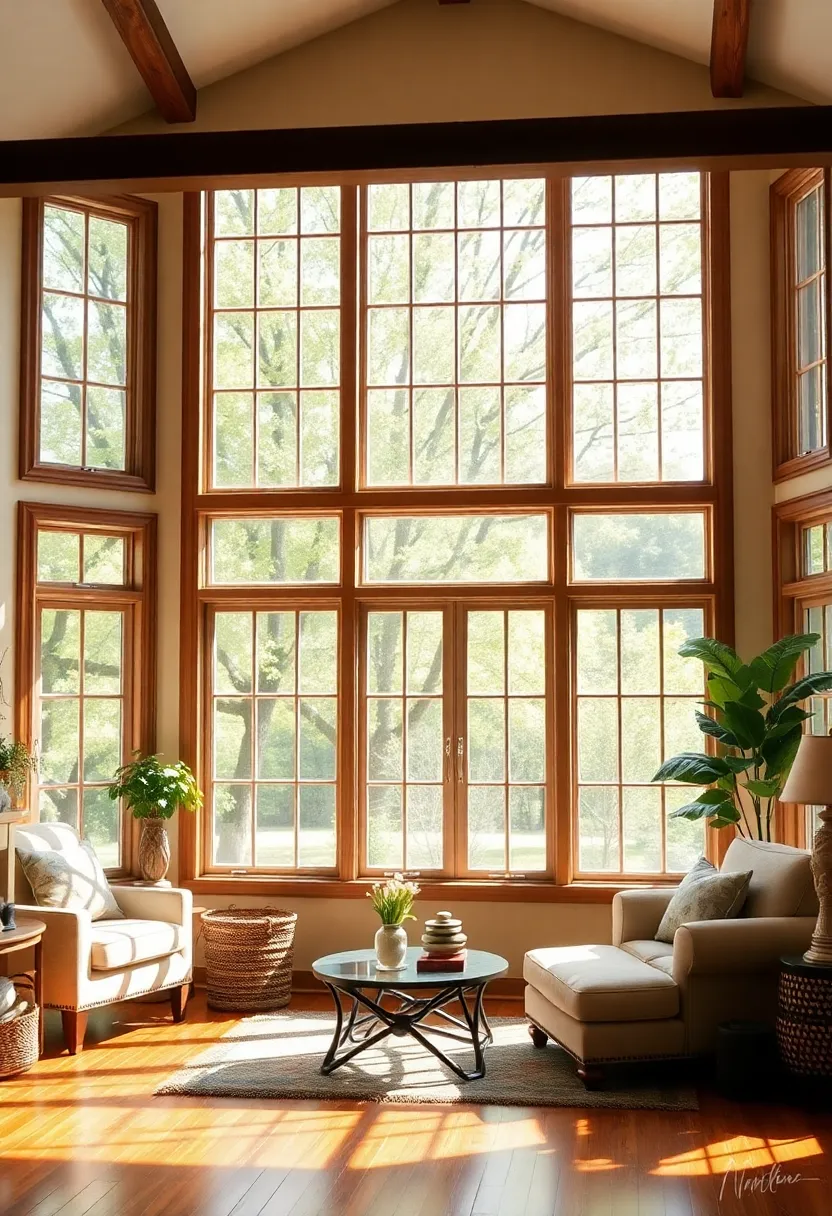
Multi-pane windows add a charming touch to your living room while allowing plenty of light. These windows consist of multiple smaller panes, offering unique design configurations that enhance your space’s aesthetics. They can suit both traditional and contemporary styles, providing versatility. Many homeowners appreciate their classic look.
When styling multi-pane windows, consider pairing them with modern décor for an eclectic feel. Adding colorful window boxes can enhance their charm and visual appeal. Ensure that the frame style complements your home’s architecture for a cohesive look. With multi-pane windows, your living room will feel bright and inviting.
• Pair with modern décor for an eclectic vibe.
• Add colorful window boxes for charm.
• Choose frame styles that complement your architecture.
• Maximize light with larger panes.
Multi-pane windows will brighten your living room while adding character.
Multi-Pane Windows
Editor’s Choice
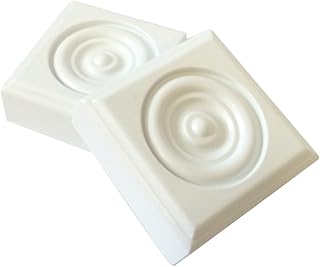
2 Piece Minute Molding Classic Plastic Block Rosette (2-3/4 in.) for Int…
 Amazon$10.54
Amazon$10.54

3 Link Wood Knot Decor – Hand Carved Coffee Table Decoration, Boho Chain…
 Amazon$14.99
Amazon$14.9929. Roman-Style Windows
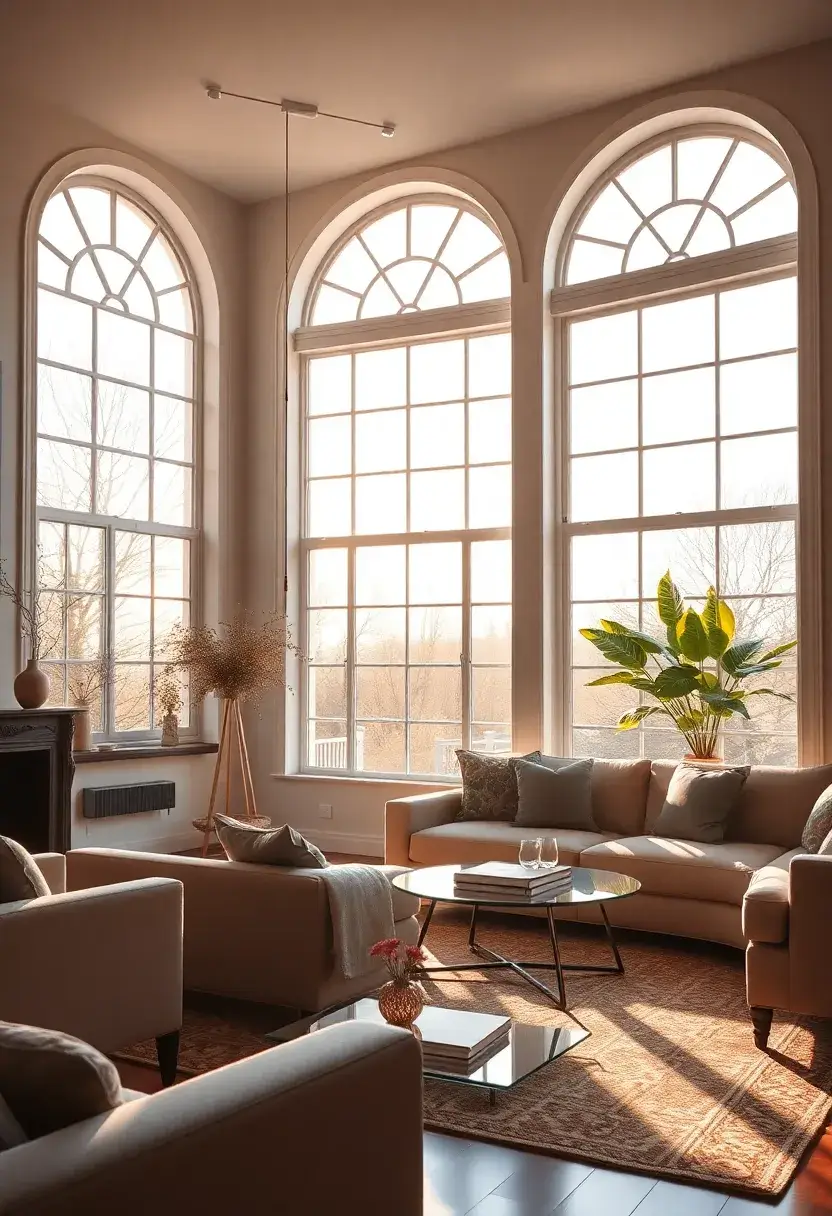
Roman-style windows add elegance to your living room while optimizing natural light. Characterized by their arched tops, these windows can be constructed in large sizes to create a focal point. Their classic design suits various décor styles, making them a timeless choice. Many homeowners appreciate their beauty and functionality.
When styling Roman-style windows, frame them with rich drapes for a luxurious feel. Pair them with classic furniture to enhance their elegance and sophistication. Utilize soft lighting to create a warm ambiance in the evening. With Roman-style windows, your living room will feel sophisticated and airy.
• Frame with rich drapes for luxury.
• Pair with classic furniture for elegance.
• Use soft lighting for evening ambiance.
• Choose light colors for a bright feel.
Roman-style windows will transform your living room into a sophisticated yet airy space.
Roman-Style Windows
Editor’s Choice

Beige and Silvery 100% Blackout Jacquard Geometric Pattern Curtains,52 I…
 Amazon$57.99
Amazon$57.99
8 Pack Antique Brass Baroque Style Drop Bail Drawer Pulls, 3-1/4 Inch Ho…
 Amazon$14.80
Amazon$14.80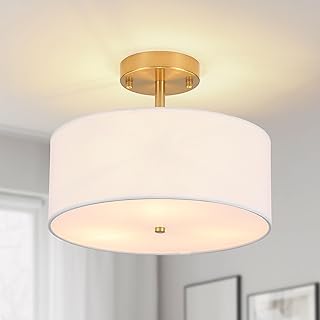
3-Light Semi Flush Mount Ceiling Light Modern Gold Drum Light Fixtures w…
 Amazon$46.74
Amazon$46.7430. Innovative Smart Windows
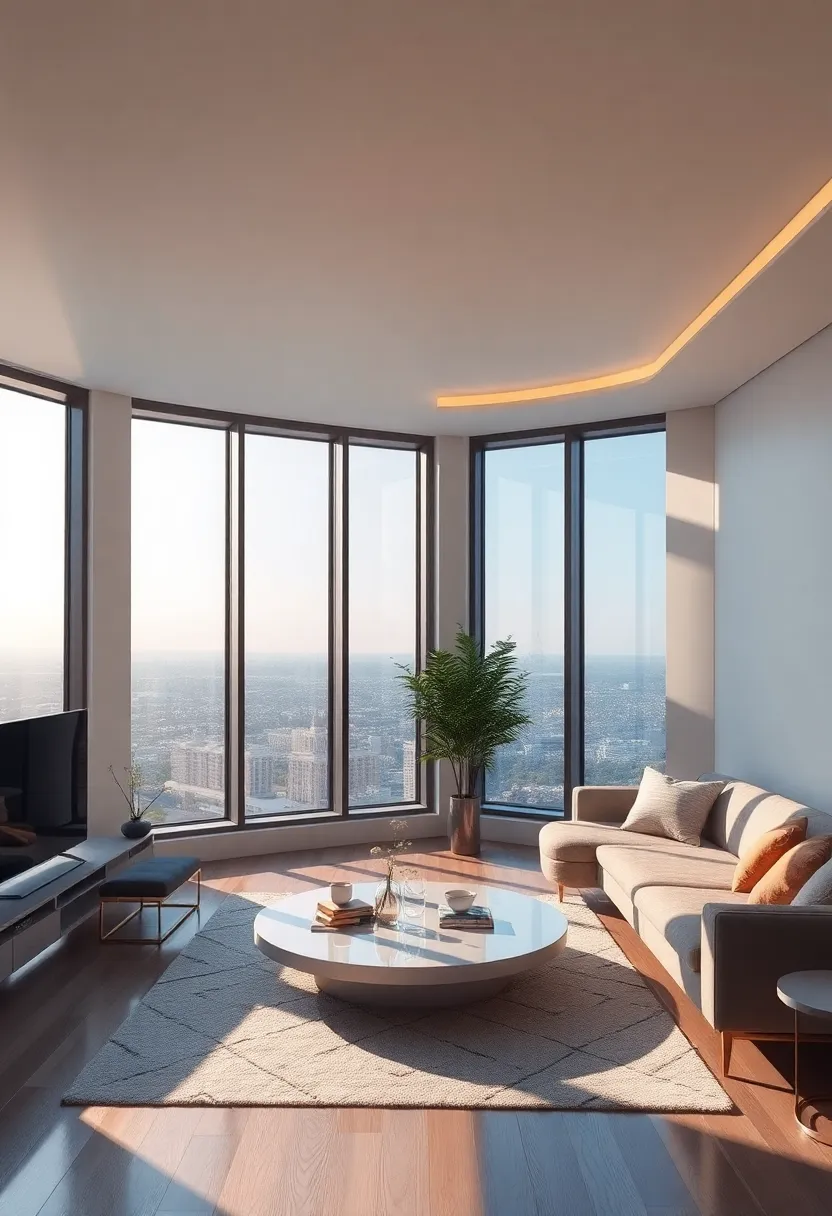
Innovative smart windows are changing the way we design living rooms, combining style with energy efficiency. These windows can tint automatically based on light levels, helping to regulate temperature while still allowing natural light in. It’s a modern solution for maintaining privacy without sacrificing brightness. Many homeowners are excited about the benefits they offer.
Smart windows help reduce energy costs by managing heat and light effectively. They can integrate into home automation systems for added convenience. With sleek designs, they fit beautifully into any modern décor, enhancing your living space. With smart windows, your living room will be stylish and energy-efficient.
• Choose designs that integrate with automation systems.
• Opt for energy-efficient styles to save on costs.
• Ensure they match your modern décor for cohesion.
• Use for natural light management effectively.
Smart windows will brighten your living room while providing a sustainable and stylish solution.
Innovative Smart Windows
Editor’s Choice

(47.5″ x 78.5″) | Window Privacy Film | PDLC Switchable, Window Film | S…
 Amazon$325.00
Amazon$325.00
Amazon Echo Hub | 8” smart home control panel with Alexa | Compatible wi…
 Amazon$179.99
Amazon$179.99
Smart Hub Bridge for Motorized Blinds Compatible with Alexa Google Home …
 Amazon$31.99
Amazon$31.99Conclusion

Large windows can truly elevate your living room experience by optimizing light and embracing the views around you.
From classic designs to modern innovations, each window idea offers unique benefits that can transform your space into a bright and inviting sanctuary. Explore these options, find inspiration, and let natural light enhance your living area!
Note: We aim to provide accurate product links, but some may occasionally expire or become unavailable. If this happens, please search directly on Amazon for the product or a suitable alternative.
This post contains Amazon affiliate links, meaning we may earn a small commission if you purchase through our links, at no extra cost to you.
Frequently Asked Questions
What Are Some Effective Large Window Ideas for Living Room Design?
If you’re looking to enhance your living room with large windows, consider options like floor-to-ceiling windows or sliding glass doors that open to a patio. These designs not only flood your space with natural light but also create a seamless connection between indoors and outdoors.
Additionally, using large windows with minimalistic frames can maximize your view and make the room feel more spacious.
How Can I Optimize Natural Light in a Small Living Room?
Optimizing natural light in a small living room can be a game changer! Use large windows to your advantage and consider light-colored walls and reflective surfaces like mirrors to bounce light around the room. You can also choose sheer window treatments that allow light to filter in while maintaining privacy.
Arranging furniture away from windows will keep the space feeling open and airy.
What Window Treatment Ideas Work Best for Large Windows?
When it comes to large windows, motorized shades or sheer curtains are excellent choices as they provide convenience and flexibility. Consider layering treatments for added texture and light control.
For a sleek look, opt for blinds that can be adjusted easily. Remember, the right window treatment can enhance your living room’s style while maximizing natural light.
How Do Large Windows Impact the Feeling of Space in a Living Room?
Large windows can dramatically impact how spacious your living room feels! They create an illusion of depth and openness, allowing the eye to travel outside and making the room feel larger.
Incorporating large windows is a fantastic way to draw in natural light, which can also enhance the overall ambiance and mood of the space, creating a more inviting atmosphere.
What Are Some Interior Design Inspirations for Living Rooms with Large Windows?
For interior design inspiration, think about combining modern minimalist styles with large windows to create clean lines and a bright environment. You can also explore Scandinavian designs that embrace natural light and simplicity.
Add cozy elements like textured throws or plants near the windows to enhance warmth and comfort while maintaining a light and airy vibe.
Related Topics
large window ideas
natural light decor
living room design
window treatment ideas
interior design inspiration
spacious living room
small space solutions
modern aesthetic
easy home updates
DIY window treatments
brighten your home
minimalist living room
Note: We aim to provide accurate product links, but some may occasionally expire or become unavailable. If this happens, please search directly on Amazon for the product or a suitable alternative.
This post contains Amazon affiliate links, meaning we may earn a small commission if you purchase through our links, at no extra cost to you.
Frequently Asked Questions
What Are Some Effective Large Window Ideas for Living Room Design?
If you’re looking to enhance your living room with large windows, consider options like floor-to-ceiling windows or sliding glass doors that open to a patio. These designs not only flood your space with natural light but also create a seamless connection between indoors and outdoors.
Additionally, using large windows with minimalistic frames can maximize your view and make the room feel more spacious.
How Can I Optimize Natural Light in a Small Living Room?
Optimizing natural light in a small living room can be a game changer! Use large windows to your advantage and consider light-colored walls and reflective surfaces like mirrors to bounce light around the room. You can also choose sheer window treatments that allow light to filter in while maintaining privacy.
Arranging furniture away from windows will keep the space feeling open and airy.
What Window Treatment Ideas Work Best for Large Windows?
When it comes to large windows, motorized shades or sheer curtains are excellent choices as they provide convenience and flexibility. Consider layering treatments for added texture and light control.
For a sleek look, opt for blinds that can be adjusted easily. Remember, the right window treatment can enhance your living room’s style while maximizing natural light.
How Do Large Windows Impact the Feeling of Space in a Living Room?
Large windows can dramatically impact how spacious your living room feels! They create an illusion of depth and openness, allowing the eye to travel outside and making the room feel larger.
Incorporating large windows is a fantastic way to draw in natural light, which can also enhance the overall ambiance and mood of the space, creating a more inviting atmosphere.
What Are Some Interior Design Inspirations for Living Rooms with Large Windows?
For interior design inspiration, think about combining modern minimalist styles with large windows to create clean lines and a bright environment. You can also explore Scandinavian designs that embrace natural light and simplicity.
Add cozy elements like textured throws or plants near the windows to enhance warmth and comfort while maintaining a light and airy vibe.
Related Topics
large window ideas
natural light decor
living room design
window treatment ideas
interior design inspiration
spacious living room
small space solutions
modern aesthetic
easy home updates
DIY window treatments
brighten your home
minimalist living room







